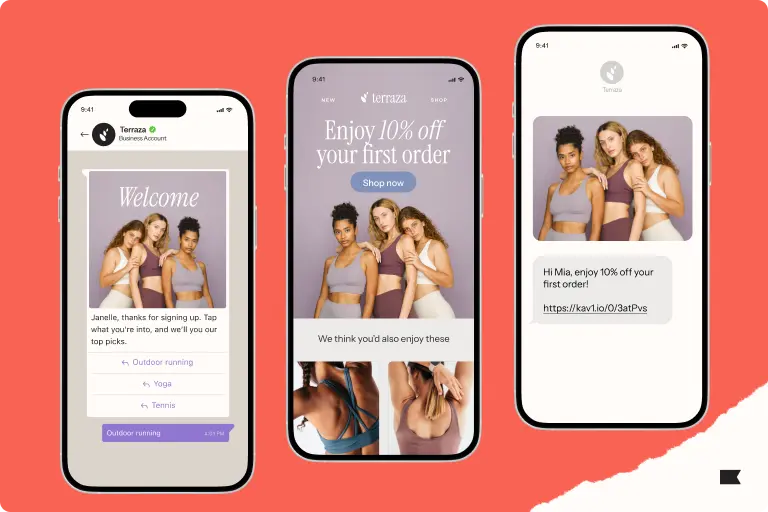Klaviyo Data Platform: the smarter, easier CDP built for faster results
Your marketing strategy is only as smart as the data you use to inform it. Brands are always looking to harness customer data to drive growth, improve personalization, and enhance the overall customer experience.
Enter: Klaviyo Data Platform (KDP)—a revolutionary customer data platform that’s extending the power of Klaviyo and reinventing the modern tech stack.
Before we dive into KDP, we need to define “customer data platform” (CDP)—the term means something slightly different to everyone you ask.
At Klaviyo, we define a CDP as a system that collects, unifies, and stores data from multiple sources at scale and makes it available for manipulation and distribution to systems of insight (CRM, analytics systems, etc.) and activation (marketing automation, advertising platforms, etc.).
CDPs were born in 2013 to help brands overcome weak data foundations in their legacy marketing solutions and deliver personalized experiences at scale.
But unfortunately, traditional, standalone CDPs aren’t built to meet the needs of scaling brands.
Wait, doesn’t Klaviyo already do this today?
You’re right—Klaviyo has been delivering CDP capabilities for years. We’re already a market leader in the CDP category on G2.
Since day one, Klaviyo’s differentiating factor has been our foundation as a customer database. Over time, we’ve layered powerful capabilities on top of this data foundation—email marketing, SMS, AI, analytics, advanced data management, and now service—all within a single, unified B2C CRM.
Because Klaviyo was built from the ground up rather than assembled through acquisitions, we provide real-time access to your data, seamless activation in one platform, and the flexibility to work with complex data—all in a way that’s intuitive for marketers and non-technical users.
KDP acts as an embedded CDP, giving businesses the benefits of a traditional CDP without the complexity. Instead of maintaining a separate system, KDP consolidates customer data, marketing, and service into a single platform.
Key benefits of an embedded CDP like KDP
- Fewer tools to manage: No need to set up or maintain a standalone CDP.
- Faster from data to action: Activate insights natively in Klaviyo without syncing data across tools or waiting on other teams.
- Seamless execution: Marketing and customer service teams can segment, personalize, and take action instantly—all from one unified interface.
Standard, built-in KDP features for every Klaviyo customer
At Klaviyo, we believe in empowering creators to own their destiny. Every business, including small businesses and entrepreneurs, should be able to maximize the value of their data without facing hefty up-sells. That’s why every Klaviyo Marketing and Service customer is entitled to these powerful standard (free) KDP features:
- Data ingestion flexibility: 350+ pre-built integrations, open APIs and SDKs, web and app tracking, and data imports allow seamless connection to any data source.
- Unified customer profiles: Take advantage of 360-degree profiles with real-time customer activity, deterministic identity resolution, automatic profile merging, identity capture, anonymous data backfill, and lifetime data retention.
- Predictive analytics: Leverage historical and predictive insights, including customer lifetime value (CLV), churn risk, average time between orders, and predicted gender.
- Real-time segmentation: Segment using all-time historical data with an intuitive drag-and-drop builder for unlimited flexibility.
- Native multi-channel activation: Orchestrate email, SMS, and push campaigns from one platform, and push segments to ad networks for real-time audience activation.
With KDP, every business can build a strong foundation for managing customer data. But as data grows more complex, managing it for consistency and accuracy while keeping it actionable gets harder.
Beyond data plumbing: unlock the full potential of your data
As your business grows, so does the complexity of your data. More sources create inconsistencies, making standardization essential. You also need flexibility to support custom data—unique events and objects beyond standard “add to cart” and “viewed product” events—while ensuring accuracy across systems. Otherwise, your data remains fragmented and less effective.
At the same time, AI and machine learning are reshaping marketing, setting new expectations for brands to personalize at scale. While most CDPs offer predictive analytics, turning those insights into action remains a challenge. A churn risk score, for example, might indicate a customer is likely to leave. But without clear next steps, it’s just a number.
Marketers need more than predictions—they need AI-driven recommendations that tell them who to target, when to act, and what will drive the best outcome.
But many CDPs still require technical expertise, creating roadblocks for marketing and customer service teams. Want to add a new data source or run an RFM analysis to identify high-value customers? That often means waiting on IT or data teams, slowing execution and limiting agility.
Unlocking the full potential of customer data requires more than just plumbing it from one system to another.
A modern data platform must handle complex data—custom events, properties, and objects—while supporting a wide range of sources and maintaining accuracy and accessibility. It should go beyond surface-level insights to deliver real, actionable intelligence, like pinpointing high-value customers with RFM analysis or optimizing cross-sell using product catalog data.
Most importantly, it must empower teams to act quickly and drive revenue—without relying on technical resources.
Advanced Klaviyo Data Platform turns data into actionable intelligence
The biggest challenge of customer data today is ensuring data is not only accessible, but truly actionable.
With Advanced KDP, you get intuitive, marketer-friendly tools to clean, standardize, and activate data in real time, without relying on technical teams. By integrating intelligence directly within the platform, Advanced KDP eliminates the need for external processing, making customer insights instantly usable for marketing, customer service, and more.
Advanced KDP consists of two components, each with its own sets of functionality: data management and intelligence.
Data management that makes your data trustworthy and actionable
While Klaviyo historically can ingest data from any source, unify it under single customer profiles through identity resolution, and store that data in a highly usable way, Advanced KDP allows for more advanced data unification, transformation, and activation, empowering you to leverage Klaviyo as the ultimate source of truth for their customer data.
Data features include:
- No-code transformations: You can transform, normalize, and adapt your data scheme to fit your business needs.
- Custom monitors: Set alerts across your data to more readily discover trends and fix potential issues.
- Hosted code functions: Enjoy unlimited customization and extensibility with serverless code functions.
- Data export: Sync data to warehouses and other third-party tools for deeper insights and personalization.
- Group membership API: Leverage segment and list membership data in Klaviyo to create dynamic personalized web experiences for each visitor to enhance the onsite customer experience and maximize conversions.
- Webhooks: Save time and maximize data consistency by exporting event data to any other system in your tech stack, at scale and in real time.

Intelligence to help you optimize all your owned channels
While Klaviyo can show how your owned marketing channels (i.e., email, SMS, push) are performing through various reporting tools, Advanced KDP expands reporting capabilities beyond marketing-centric insights.
Delve into audience-level and business-level performance analysis with tools like funnel analysis, RFM modeling, customizable CLV, and audience performance comparisons. This enables the creation of insights-driven personas and opens doors for optimization and re-engagement.
Intelligence features include:
- RFM analysis: Group customers based on purchase recency, frequency, and monetary value to create more strategic segments and gain a deeper understanding of customer behaviors.
- Product analysis: Increase sales with AI-driven product and bundle recommendations that boost repeat purchases and average order values.
- Funnel and cohort analysis: Investigate breaks in the customer funnel and identify opportunities to improve conversions by analyzing different stages in the customer journey.
- Audience performance reporting: Compare audience segments based on size, change over time, and conversions by channel, for any date range, to address negative trends and identify top segments faster.
- Customizable CLV: Enhance CLV forecasting by customizing the prediction window, allowing you to better segment customers and personalize messages for them.

What you can expect from Advanced KDP
- Accurate, reliable data for relevant personalization: Ensure your data is clean and up to date, enabling you to deliver highly relevant, real-time personalized experiences across all touchpoints.
- Extended data value for business-wide impact: Seamlessly export data for business intelligence analysis, in-house modeling, and on-site personalization to drive smarter decisions and better outcomes across your tech stack.
- Smarter marketing, more revenue: Maximize customer spend by promoting the right products, converting high-value shoppers, and re-engaging lapsed customers—leading to higher order values and increased sales.
- Elevated customer service and boost retention: Empower your service teams with data-driven insights to deliver personalized support, increasing satisfaction, retention, and CLV.
A consolidated tech stack with Klaviyo is going to allow multiple efficiencies in my company.
I’m going to be able to create extra bandwidth with my employees and I’m going to be able to touch my end users a lot easier.
Unrivaled differentiation to drive sustainable growth
KDP redefines what a CDP can be by embedding data, intelligence, and activation into a single seamless system, eliminating the need for constant data syncing across disconnected tools.
With standard features like lifetime data retention, real-time segmentation, and an easy-to-use interface designed for non-technical users, every Klaviyo Marketing and Service customer can unify their data, personalize engagement, and drive growth without extra costs.
For those looking to go further, Advanced KDP unlocks sophisticated data management and intelligence. Gain deeper insights, run smarter marketing campaigns, and deliver more impactful customer experiences, all while consolidating your tech stack and reducing complexity.
With minimal implementation required, getting started is a breeze—Klaviyo customers can get set up in minutes.


Related content

Discover how audience filters let you personalize every message in an omnichannel campaign using real-time data, behavior, and channel preferences.

Klaviyo welcomes Chano Fernández as Co-CEO to help accelerate global growth and lead the next era of AI-powered customer experiences.

Discover how cross-channel marketing and the rise of SMS shaped BFCM 2025. Learn why email + text orchestration drove record engagement, efficiency, and revenue.